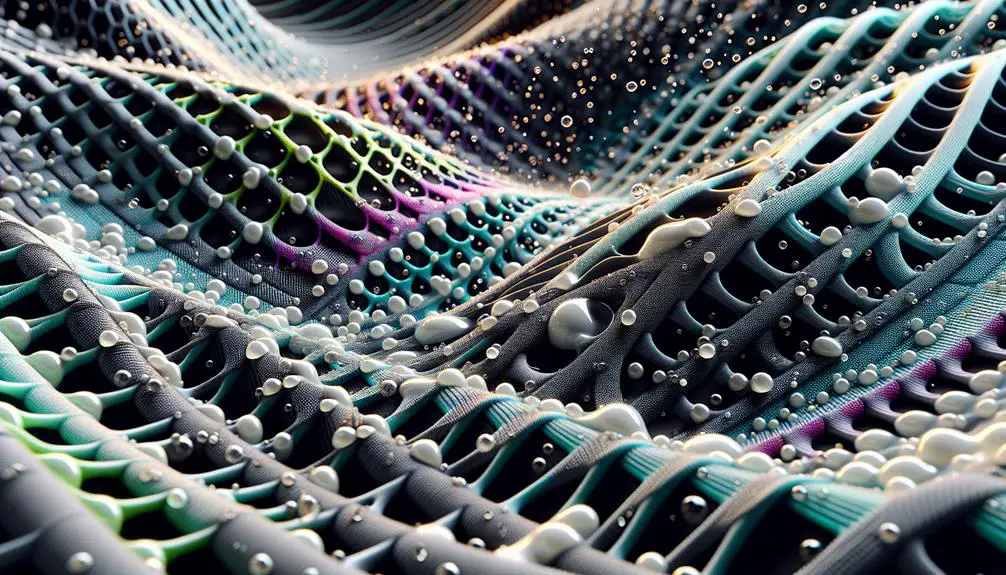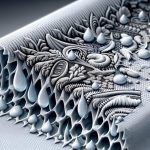When you think about the latest innovations in moisture management textiles, it's fascinating how these advancements can transform your comfort and performance. Imagine fabrics that not only wick away sweat but also dry quickly, keeping you cool and dry throughout your activities. Beyond this, there are odor-resistant materials and smart textiles that adapt to your body's needs in real-time. These innovations aren't just about comfort; they also incorporate sustainable fibers and advanced treatments that offer long-term durability. But what really sets these technologies apart?
Table of Contents
Key Takeaways
- Advanced wicking fabrics pull moisture from the skin, facilitating quick evaporation for enhanced comfort and athletic performance.
- Quick-drying technologies employ advanced fabric blends and hydrophobic coatings to ensure fast drying, water resistance, and breathability.
- Antimicrobial fabric technologies and silver ion infusion combat bacteria, keeping textiles odor-free and hygienic.
- Smart textiles with embedded sensors offer real-time moisture monitoring and dynamic response to activity levels.
- Sustainable fibers like organic cotton, bamboo, and Tencel provide eco-friendly, biodegradable options with excellent moisture-wicking properties.
Advanced Wicking Fabrics
Advanced wicking fabrics, designed to keep you dry and comfortable, are revolutionizing the textile industry through innovative moisture management techniques. You'll find that these performance fabrics excel at sweat management, ensuring you remain at your peak, whether you're in the gym or on a hike.
The unique structure of these technical textiles pulls moisture away from your skin, dispersing it across the fabric's surface where it can quickly evaporate.
By incorporating moisture wicking innovations, manufacturers are creating garments that not only enhance comfort but also improve athletic performance. Imagine running a marathon without the discomfort of clingy, sweat-soaked clothes.
These fabrics work tirelessly to maintain ideal body temperature and dryness, allowing you to focus on your activity instead of your attire.
Technical textiles are engineered to handle the most demanding conditions. They combine advanced synthetic fibers with strategic weaving techniques to create a fabric that's lightweight, breathable, and incredibly efficient at moisture transport.
When you choose performance fabrics equipped with these innovations, you're investing in apparel that supports your ambitions, keeps you comfortable, and enhances your overall experience.
With these advanced wicking fabrics, you'll never let sweat stand in the way of your goals.
Quick-Drying Technologies
You'll find that quick-drying technologies are revolutionizing how we stay comfortable and dry.
Advanced fabric blends, hydrophobic coatings, and airflow ventilation systems all play an essential role in speeding up moisture evaporation.
Let's explore how these innovations enhance the performance and comfort of modern textiles.
Advanced Fabric Blends
In the world of textiles, quick-drying technologies are revolutionizing fabric blends to keep you comfortable and dry. Today's advanced fabric blends combine moisture wicking properties and eco-friendly options, ensuring you get the best of both worlds. These fabrics excel in innovative performance while remaining committed to sustainable solutions. Imagine working out or hiking without the discomfort of sweat-soaked clothing. That's the promise of these advanced blends.
| Feature | Moisture Wicking Blends | Eco-Friendly Options |
|---|---|---|
| Material | Polyester, Nylon | Organic Cotton, Bamboo |
| Drying Speed | Fast | Moderate |
| Sustainability | Moderate | High |
| Comfort | High | High |
| Durability | Excellent | Good |
Quick-drying technologies leverage synthetic fibers like polyester and nylon, known for their moisture wicking capabilities, to pull sweat away from your skin. On the other hand, eco-friendly options like organic cotton and bamboo are gaining traction for their lower environmental impact. These sustainable solutions might not dry as quickly, but they offer a balance of comfort and environmental responsibility. By selecting the right blend, you achieve both high performance and sustainability in your activewear and everyday clothing.
Hydrophobic Coatings
Building on the benefits of advanced fabric blends, hydrophobic coatings elevate moisture management to the next level by repelling water entirely. When you use textiles treated with these coatings, you're not just wearing fabric; you're equipping yourself with waterproof durability and moisture repellent performance that keeps you dry and comfortable, regardless of the conditions.
Hydrophobic coatings work by creating a barrier on the fabric's surface, causing water to bead up and roll off instead of soaking in. This technology is ideal for athletes, outdoor enthusiasts, and anyone else who requires their gear to perform under wet conditions.
Here are some key advantages:
- Enhanced Waterproof Durability: Secures that your garments endure multiple washes without losing their water-repelling capabilities.
- Quick-Drying: Allows fabrics to dry swiftly, reducing downtime and keeping you prepared for action.
- Stain Resistance: Preserves your clothes' appearance by preventing liquids from infiltrating the fibers.
- Breathability Maintenance: While repelling water, these coatings still enable air to flow through, ensuring comfort and preventing overheating.
Airflow Ventilation Systems
To further optimize moisture management, airflow ventilation systems seamlessly integrate with quick-drying technologies to keep you cool and dry. These systems are designed to enhance temperature control by allowing air to circulate through the fabric, aiding in the evaporation of sweat more efficiently.
When you're engaged in high-intensity activities, your body generates heat and moisture. Effective airflow ventilation ensures that this excess heat is dissipated, preventing overheating and maintaining a comfortable microclimate next to your skin.
Moisture regulation is another critical benefit of these advanced systems. By promoting continuous air movement, these textiles reduce the buildup of sweat, minimizing the risk of chafing and skin irritation. The quick-drying aspect works hand-in-hand with ventilation, guaranteeing that any moisture wicked away from your body evaporates swiftly.
This dual functionality not only enhances your comfort but also extends the longevity of the fabric, as it remains dry and less prone to bacteria growth.
Mastering the balance of temperature control and moisture regulation through these innovations means you can push your limits without feeling weighed down by sweat-soaked clothing. These technologies represent the cutting edge of textile engineering, offering you unparalleled performance and comfort.
Odor-Resistant Materials
When you're choosing odor-resistant materials, you're likely looking at antimicrobial fabric technologies that help keep smells at bay.
Silver ion infusion is another popular method that actively combats bacteria growth.
Natural fibers also offer inherent benefits, making them a great option for freshness.
Antimicrobial Fabric Technologies
Antimicrobial fabric technologies play an essential role in keeping textiles odor-free and extending their usability. When you choose fabrics with these technologies, you're investing in materials that resist bacteria, fungi, and other microorganisms. This means your textiles not only stay fresher longer but also maintain their integrity and appearance over time.
Key benefits of antimicrobial fabrics include:
- Enhanced Fabric Durability: By preventing microbial degradation, these technologies help your clothes and gear last longer, making them a wise investment.
- Allergen Resistance: You'll find that antimicrobial fabrics can reduce allergens in your environment, which is particularly beneficial if you have sensitivities or allergies.
- Odor Control: Say goodbye to stubborn odors. Antimicrobial treatments work at the microscopic level to eliminate the bacteria that cause unpleasant smells.
- Hygienic Comfort: Enjoy the peace of mind that comes with knowing your textiles are cleaner and more hygienic, whether you're at the gym or on a long hike.
Silver Ion Infusion
Building upon the advantages of antimicrobial technologies, silver ion infusion emerges as a standout method for creating odor-resistant materials. When silver ions are embedded into textiles, they provide a strong defense against bacteria that cause unpleasant smells. These ions disrupt the cellular processes of bacteria, effectively preventing their growth and reproduction. This means your garments stay fresher for longer, reducing the need for frequent washing and extending the life of the fabric.
The silver ion benefits don't stop at odor resistance. They also enhance the overall hygiene of your clothing, making it ideal for high-performance and everyday wear alike. Regarding textile applications, you'll find silver ion-infused fabrics used in activewear, socks, underwear, and even medical textiles. This technology is particularly advantageous in scenarios where maintaining cleanliness is essential, such as in healthcare settings or during intense physical activities.
Silver ion infusion integrates seamlessly into various types of fabrics without compromising their comfort or breathability. By incorporating these advanced materials into your wardrobe, you're not only investing in superior odor control but also in the long-term durability and performance of your textiles.
Natural Fiber Benefits
Natural fibers like wool and bamboo offer excellent odor-resistant properties, making them a valuable choice for wearable textiles. You'll appreciate that these materials not only keep unpleasant smells at bay but also bring several other benefits to the table.
Firstly, natural fibers possess eco-friendly properties. Unlike synthetic alternatives, they're biodegradable and have a lower environmental impact. This makes them a smart option for those who prioritize sustainability.
Secondly, the moisture-wicking benefits of wool and bamboo are remarkable. These fibers effectively draw moisture away from your skin, keeping you dry and comfortable throughout the day. This is particularly advantageous for activewear and outdoor clothing.
Here are a few more natural fiber advantages:
- Odor Prevention: Natural antimicrobial properties help reduce the growth of odor-causing bacteria.
- Breathability: These fibers allow air to circulate, enhancing comfort and reducing perspiration.
- Softness: Natural fibers like bamboo are incredibly gentle against the skin, providing a luxurious feel.
- Versatile Applications: From everyday wear to specialized sports gear, these fibers can be used in a wide range of textile products.
Smart Textiles
In the field of moisture management, smart textiles leverage cutting-edge technology to enhance comfort and performance. Imagine clothing that not only absorbs sweat but also tracks your hydration levels. With embedded sensors, smart textiles can monitor your body's moisture levels in real-time. These sensors can detect sweat and send data to your smartphone, allowing you to adjust your activity or hydration on the fly.
This kind of wearable technology transforms how you engage in sports, work, and daily life.
The beauty of smart textiles lies in their seamless integration into everyday wear. They offer more than just moisture-wicking properties; they actively manage your body's environment. For instance, some smart fabrics can adjust their breathability based on your activity level, ensuring peak comfort whether you're running a marathon or sitting in a meeting. This dynamic response is achieved through advanced fabric engineering and microelectronics.
Sustainable Fibers
As smart textiles revolutionize how we interact with our clothing, sustainable fibers are equally transforming the materials we use, emphasizing eco-friendliness and reducing environmental impact. By integrating eco-friendly alternatives into your wardrobe, you're not just enhancing your comfort but also making a conscious choice for the planet.
Sustainable fibers are crafted through sustainable production methods, ensuring minimal environmental footprint. Unlike conventional textiles, these fibers prioritize ethical sourcing, ensuring fair labor practices and responsible resource use. You'll find that biodegradable fibers, such as organic cotton and Tencel, break down naturally, reducing landfill waste and pollution.
Consider these notable sustainable fibers:
- Organic Cotton: Grown without harmful pesticides, it's soft, breathable, and gentle on your skin.
- Bamboo: Known for its rapid growth and renewability, bamboo fabric is incredibly soft and moisture-wicking.
- Tencel (Lyocell): Made from sustainably sourced wood pulp, it's biodegradable and highly absorbent.
- Recycled Polyester: Transforms plastic waste into versatile, durable fabric, reducing reliance on virgin materials.
Nanotechnology in Textiles
Nanotechnology is transforming textiles by enhancing their functionality with advanced properties like water resistance and increased durability. Imagine clothing that not only keeps you dry but also remains pristine after multiple washes. With nano fiber applications, this isn't just a dream—it's reality. By integrating nanotechnology into textile fibers, manufacturers can create fabrics with exceptional moisture control advancements. These nano fibers can wick moisture away from your skin, guaranteeing you stay comfortable and dry, no matter the activity.
You'll find that textiles treated with nanotechnology possess superior water resistance. Tiny nanoparticles are embedded within the fabric structure, establishing a barrier that repels water while still allowing air to circulate. This means you won't have to compromise breathability for water resistance. Additionally, these innovations lead to increased durability. Nano fibers make the fabrics stronger and more resistant to wear and tear, extending the lifespan of your garments.
For those passionate about high-performance textiles, understanding and utilizing these moisture control advancements is crucial. Embrace the future of fashion and function, where nano fiber applications assure your attire is always at its best, no matter the conditions.
Phase Change Materials
Beyond the advancements in nanotechnology, Phase Change Materials (PCMs) are revolutionizing how textiles manage moisture and temperature. You're probably aware that PCMs can absorb, store, and release thermal energy during phase shifts between solid and liquid states. This property makes them ideal for integrating into textiles for superior thermal regulation.
Imagine wearing a fabric that adapts to your body's temperature fluctuations. When you're hot, the PCM absorbs excess heat, cooling you down. Conversely, when you're cold, the PCM releases stored heat, warming you up. This dynamic thermal regulation not only enhances comfort but also contributes to energy efficiency by reducing the need for additional heating or cooling layers.
Consider the following benefits of PCMs in textiles:
- Enhanced comfort: PCMs maintain an ideal temperature, reducing the discomfort caused by sudden temperature changes.
- Energy savings: By regulating temperature, PCMs help you use less energy for heating and cooling.
- Improved performance: Ideal for activewear, PCMs can help maintain a stable body temperature, boosting athletic performance.
- Versatility: PCMs can be integrated into various types of fabrics, from everyday clothing to specialized gear.
Incorporating PCMs into textiles is an innovative step towards creating smart, energy-efficient fabrics that adapt to your needs.
Breathable Membranes
Breathable membranes in textiles let sweat escape while keeping you dry by blocking external moisture. Imagine you're on a hike: your body generates heat and sweat, but you stay comfortable because the latest membrane technology in your jacket allows vapor to pass through while repelling rain. This dual function is essential for effective moisture control.
Mastering sweat management requires understanding how breathable fabrics work. These membranes are typically microporous, meaning they've tiny holes that are small enough to block water droplets but large enough to let water vapor escape. As you sweat, the vapor moves through the fabric and evaporates, keeping you dry and comfortable.
High-performance textiles use advanced membrane technology to balance breathability and waterproofing. You'll find these materials in outdoor gear, athletic wear, and even everyday clothing. The key is in the fabric's ability to facilitate moisture control without compromising on protection against the elements.
Choosing the right breathable fabrics can make a significant difference in comfort and performance. By leveraging cutting-edge membrane technology, you're ensuring that your clothing meets the highest standards of sweat management and moisture control. This allows you to focus on your activities without worrying about discomfort.
Antibacterial Treatments
You're always looking for textiles that not only manage moisture but also stay fresh and hygienic.
Antibacterial treatments, like advanced fabric coatings and nano-silver technology, provide long-lasting protection against bacteria.
You'll find these innovations essential in keeping your garments odor-free and clean.
Advanced Fabric Coatings
In recent years, antibacterial treatments have revolutionized fabric coatings by enhancing hygiene and durability in textiles. When you want to combine these treatments with moisture wicking coatings, you're diving into the world of advanced fabric technology that promises unmatched comfort and performance. These innovative fabric treatments not only keep you dry but also safeguard against harmful microbes, giving you peace of mind.
Waterproof textiles have also greatly benefited from these antibacterial coatings. They guarantee that your gear remains untainted even in the dampest conditions. This dual functionality is perfect for outdoor enthusiasts and athletes who require both protection and hygiene.
Consider the benefits of these advanced fabric coatings:
- Enhanced Hygiene: Antibacterial treatments reduce the risk of infections by inhibiting microbial growth.
- Long-Lasting Freshness: These coatings help maintain the freshness of textiles, even after multiple washes.
- Improved Durability: Fabrics treated with antibacterial coatings are more resistant to wear and tear.
- Versatile Applications: From sportswear to medical textiles, the applications are vast and varied.
Nano-Silver Technology
When it comes to antibacterial treatments in textiles, nano-silver technology stands out for its effectiveness and versatility. Silver nanoparticles are tiny particles of silver that are incredibly efficient in eliminating bacteria. You'll find these nanoparticles integrated into various textile applications, ranging from athletic wear to medical fabrics. The science is straightforward: silver ions disrupt bacterial cell membranes, effectively killing harmful microbes and preventing their growth.
Incorporating silver nanoparticles into textiles brings several benefits:
| Benefit | Description |
|---|---|
| Antibacterial | Kills bacteria and prevents their growth |
| Odor Control | Reduces unpleasant odors from sweat |
| Durability | Maintains effectiveness over time |
These benefits make nano-silver technology an excellent choice for anyone looking to enhance the performance and hygiene of their fabrics. Whether you're concerned about maintaining freshness during intense workouts or ensuring sterility in medical environments, silver nanoparticles can meet your needs. Additionally, integrating this technology into textile applications doesn't compromise the fabric's breathability or comfort, making it a versatile solution.
To master the use of nano-silver technology in textiles, you should focus on understanding how it interacts with different fabric types and their specific requirements. This knowledge will help you leverage the full potential of silver nanoparticles in your textile applications.
Long-Lasting Protection
To achieve long-lasting defense in textiles, prioritize antibacterial treatments that maintain their effectiveness over extended periods. You'll find that advanced formulations not only combat bacteria but also integrate seamlessly with moisture locking technology, guaranteeing enduring performance. This combination is essential for preserving the integrity and hygiene of your fabrics.
To maximize the benefits of antibacterial treatments in textiles, consider these key strategies:
- Choose high-quality antibacterial agents: Opt for treatments that offer proven, prolonged protection against a wide range of bacteria.
- Leverage moisture locking technology: This aids in improved moisture control, keeping textiles dry and free from bacterial growth.
- Focus on lasting performance: Ensure the treatment withstands multiple wash cycles without losing effectiveness.
- Seek eco-friendly options: Go for sustainable antibacterial treatments that are gentle on the environment but tough on bacteria.
Thermoregulating Yarns
Thermoregulating yarns, designed to adapt to temperature changes, offer an innovative solution for maintaining ideal comfort in various climates. You'll find these yarns excel in both thermal comfort and moisture control, making them perfect for any weather condition. By integrating phase change materials (PCMs) or other advanced technologies, these yarns can absorb, store, and release heat as needed. This results in a fabric that keeps you warm when it's cold and cool when it's hot.
To better understand the benefits, let's compare traditional yarns with thermoregulating yarns:
| Feature | Traditional Yarns | Thermoregulating Yarns |
|---|---|---|
| Temperature Adaptability | Low | High |
| Moisture Control | Basic | Advanced |
| Thermal Comfort | Inconsistent | Consistent |
| Suitability for All Climates | Limited | Extensive |
Thermoregulating yarns offer a significant upgrade, especially if you're active or live in regions with fluctuating temperatures. These yarns manage moisture efficiently, wicking sweat away from your skin to keep you dry. They also enhance thermal comfort by maintaining a stable microclimate around your body. If you're aiming for mastery in textile technology, incorporating thermoregulating yarns into your products can set you apart. Embrace this innovation to achieve superior performance and comfort.
Frequently Asked Questions
How Do Moisture Management Textiles Impact Skin Health?
You'll find that fabric technologies and textile advancements enhance skin hydration by improving sweat absorption. These innovations keep your skin dry and comfortable, reducing irritation and promoting better overall skin health.
What Are the Best Practices for Caring for Moisture-Wicking Fabrics?
Imagine your fabric as a well-tuned instrument; proper care guarantees harmony. Use gentle washing tips, air drying techniques, and prompt stain removal. For odor control, avoid fabric softeners. Master these practices, and your garments will last longer.
How Do Traditional Fabrics Compare to Modern Moisture Management Textiles?
Traditional fabrics don't match modern textiles in fabric performance and moisture control. You'll find that advanced materials wick sweat away more efficiently, keeping you dry and comfortable, whereas older fabrics tend to retain moisture.
What Industries Benefit Most From Moisture Management Innovations in Textiles?
The impact is astronomical! You'll find sports performance and outdoor apparel industries benefit the most. They require advanced moisture management to enhance comfort, performance, and endurance, ensuring you're always at your peak, no matter the conditions.
Are There Any Specific Certifications for High-Performance Moisture Management Textiles?
Yes, you'll find specific certification standards for high-performance moisture management textiles. They include rigorous performance testing techniques like Wicking Test and Moisture Vapor Transmission Rate to guarantee the textiles meet industry benchmarks.
- Is Polycotton Soft? A Guide to Its Texture and Feel - June 23, 2025
- What Are the Advantages and Disadvantages of Polycotton? - June 23, 2025
- What Is Recycled Polycotton? an Eco-Friendly Fabric Guide - June 23, 2025







